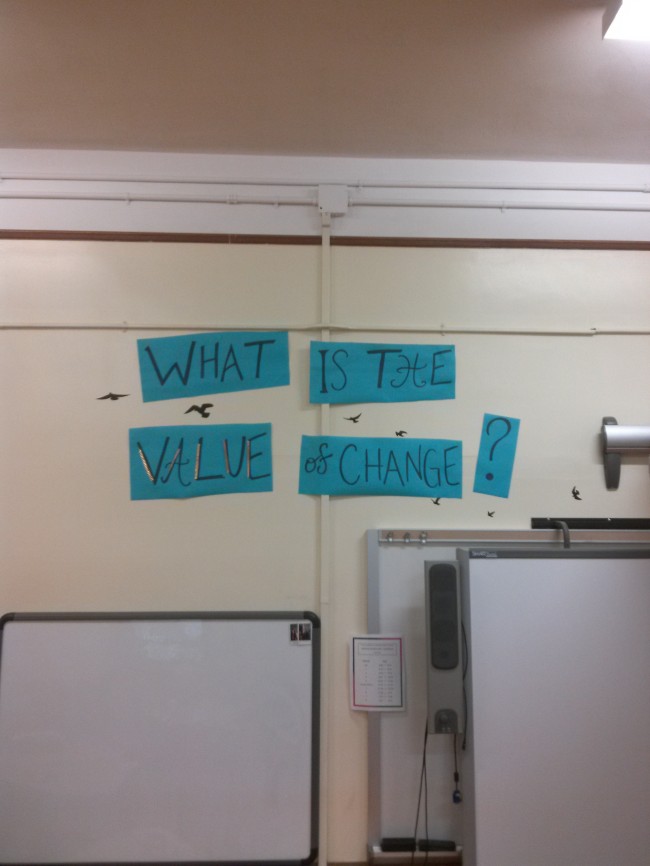There comes a time in any healthy relationship where space needs to be granted for people to thrive as individuals, not just as part of a unit. The same is true for classrooms. Teachers and students alike need an environment with breathing room so there’s space to grow and deal with the complex mental tasks of our daily work.
As all English teachers know, literature similarly plays out this real life tenet: WHERE we are contributes to WHO we are. For this reason, over the years, I have become more and more passionate about making sure my classroom is a supportive environment students can thrive in as leaders. A few ideas on how to make the most of your space are below. Hope they are inspiring. 🙂
- ‘THE WALLS DO TALK HERE’ ideas:
– My essential question of the year is posted [somewhat] ornately on the wall to help serve as a reminder of the thread that connects each unit: CHANGE.
– Students share their creative expressions on the “things that make us smile wall.” I set up three magnet strips against an area of the wall about 2 feet long and 2 feet high to aid the easy put up/take down feature to this area. Most often students post little quotes or poems they come up with, doodles, and pictures of celebrities. This year, though, some original thinker went ahead and taped a lemon head to the wall. Amazing.
- ‘TACTILE AND TANGIBLE’ ideas. The world has texture, the classroom should be full of it too:
– If you can paint your room, don’t hesitate! Last year I painted one accent wall and this year was lucky enough to have a talented coworker do a flower painting. I wanted my classroom to feel like a tree house and to get the job done, Materials For The Arts was a great source for grass and plants. School Specialty on amazon.com was my source for backing paper choices like weathered wood.

- It may be “NEGATIVE SPACE” but it’s a POSITIVE quality: So those walls that talk… yeah they are important. But, it shouldn’t be as if they don’t shut up. I’ve learned this the hard way because I near constantly fight the urge to put all of my students’ work up on the walls, or print and share all the funny signs I see on the Internet. This past spring though, a student walked into my room and said “Wow. It feels different in here. I can think better now that the projects came off the wall.” It was then I started to take that priority of “white space” or “negative space” more seriously. In a world where more and more kids have issues with focus and attention, the environment we create in our classrooms can’t be a distraction. This extends into other aspects of teaching space as well, like activities where students need to sort ideas or opinions on chart paper. I’ve started to always leave a blank page for the tangents, or the “not immediately sort-able” stuff student minds might go to. This gives them the space to take some risks and unhinge where their mind is taking them, not censor something that may very well be the kernel idea for some great writing.

Since setting is just as important in literature for its role in the development of conflict and characterization, here are a few recommendations for books that kill it in a classroom dialogue on the concept:
*Mystic River by Dennis Lehane (crime bosses allowing drugs to be sold in nearby towns but not their own, anger issues from being raised in poverty, and forests full of secrets and bodies resembling the muddy areas of the protagonists’ minds).
*Tracks by Louise Erdrich (the setting as a villain; Native American tribes betrayed by the very land in North Dakota they are fighting for and pray to… The opening line: “We started dying before the snow and like the snow we continued to fall,” !!! Breathtakingly written).
*Beast by Walter Dean Myers (setting code switching occurs in this book with a protagonist floating between two worlds: a Connecticut prep school and Harlem).










